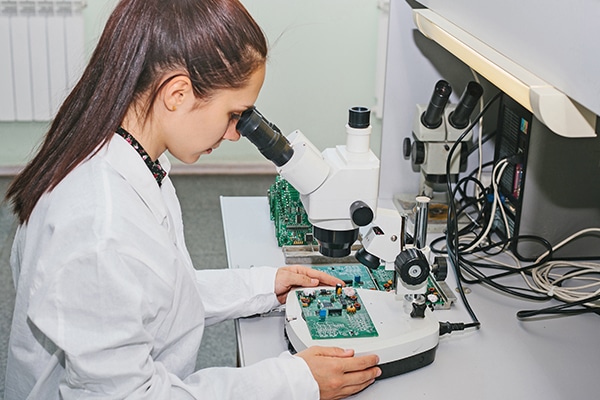Advanced technologies are revolutionising PCB inspection, addressing hidden flaws and raising manufacturing benchmarks.

If you work in electronics, you have likely faced this issue: traditional magnification systems no longer suffice for PCB inspection or rework. They lack the required magnification levels and fail to provide an efficient way to capture photos or document your work.
So, what do PCB manufacturers do when they need an advanced solution? They look for tools that meet their exacting standards.
Whether a manufacturer or a supplier, you understand the importance of efficient and reliable PCB inspection. It is not just about identifying defects; it is about ensuring product quality during quality control, rework, failure analysis, and research and development.
PCB performance depends on components such as soldering, through holes, diodes, and IC chips, which must be thoroughly inspected. A reliable imaging solution is also essential to document compliance with required standards.
This is where inspection microscopes are critical in ensuring your boards meet expectations.
But why is all of this so important?
Detecting defects early—such as micro-cracks or poor solder joints—prevents costly problems later. Industries such as aerospace, automotive, and medical have high stakes, with stringent standards for PCBs. High-quality microscopes help ensure compliance, prevent recalls, and guarantee safety.
Moreover, faster inspection times accelerate production cycles, enabling you to meet deadlines without compromising quality.
Ultimately, the right microscope for PCB inspection does more than identify flaws; it enhances the efficiency and reliability of the entire process. With the right tools, every board can meet the highest standards, producing durable, reliable products.
Table of Contents
Also Check: High-Speed PCB Design Guide
Next-level PCB Inspection
Integrating a 4K stereo digital microscope has transformed electronics manufacturing and quality control by offering unparalleled clarity in viewing PCB details. Paired with 30 or 60 frames per second (fps), this technology provides a fluid, real-time visual experience, capturing every detail of the components under inspection without blurring.
Higher frame rates are particularly beneficial during dynamic processes such as soldering or component adjustment under the microscope. Smooth image delivery ensures accurate identification of potential issues and minimises errors during rework, guaranteeing high-quality outcomes.
Professionals in the electronics industry require tools that meet the demands of their work. Combining high frame rates with 4K digital microscopes significantly enhances quality control and rework operations, making this feature indispensable when choosing inspection equipment.
Understanding the benefits of these advancements is essential for improving quality control practices and ensuring reliable inspection tools.
Adding to the technological toolkit, stereo zoom microscopes are designed for binocular optical inspection, which is ideal for viewing PCBs with both eyes. These microscopes feature electrostatic discharge (ESD)-safe properties, preventing damage to components caused by human static charge. Using ESD-safe paint or earthing mechanisms ensures that the static charge does not transfer to components.
Stereo zoom microscopes are also designed for flexibility, with butterfly-type eyepieces that allow left and right sliding adjustments for users with varying eye distances. An antifungal coating on optical components makes these microscopes suitable for open environments, protecting them from dust and fungal growth.
High-performance microscopes now feature high-resolution cameras, automatic height adjustment, auto-focus, significant magnification, and magnetic lens attachments. With user-customisable profiles and software enhancements, they support 4K Ultra HD imaging, offering four times the pixel count of traditional HD.
This upgrade improves the inspection of low-contrast and reflective subjects, enhancing documentation and collaboration.
| 2D vs 3D Microscopes |
| Microscopes are key in modern manufacturing and inspection processes, offering 2D and 3D imaging capabilities tailored to specific needs. The choice between these technologies depends on the level of detail required and the complexity of the task. • 2D microscopes: Suitable for inspecting plastic and metal parts or for assembly tasks where fine detail is not essential. They offer faster scanning, saving operators’ time. Frequently employed in production environments to identify nano-scale features and minimise human error. • 3D microscopes: Essential for inspecting PCBs and critical features that require high precision, such as chamfers, curvatures, or depth. Provide depth perception and the ability to view from both top and bottom angles, making them suitable for detailed, complex tasks. • Application-based selection: The choice between 2D and 3D depends on the specific task. For simple presence checks, 2D is sufficient; for more critical, detailed inspections, 3D is necessary. 3D systems are often employed for tasks involving hanging or intricate structural components. • Visibility of microscopic parts: Advanced microscopes, like monozoom models with 2D imaging, reveal nano-sized parts invisible to the naked eye, enabling detailed inspection to ensure quality and functionality. These capabilities are instrumental in maintaining stringent quality standards. • Enhanced production and reduced errors: Choosing the right imaging technique boosts production efficiency and minimises errors. 2D systems suit straightforward assembly tasks, while 3D systems excel in complex PCB manufacturing. |
Advancements in Microscope Design










